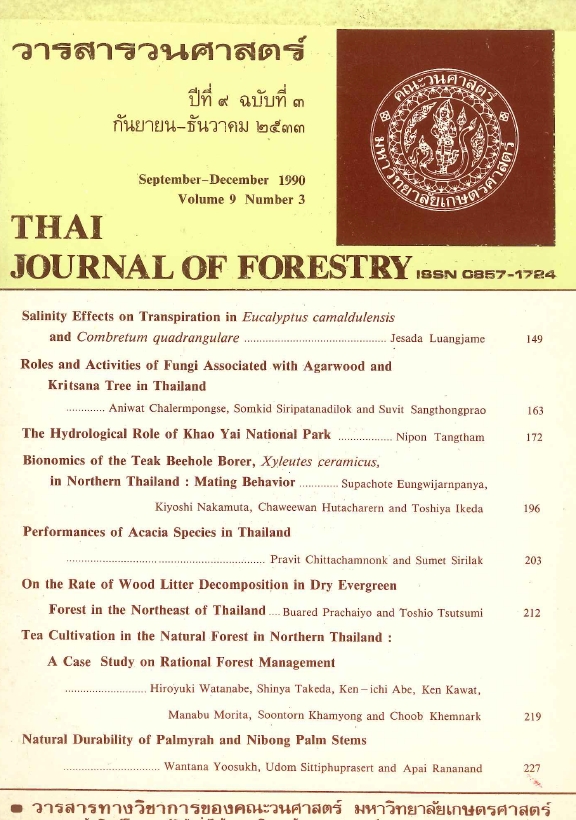TEA CULTIVATION IN THE NATURAL FOREST IN NORTHERN THAILAND : A Case Study on Rational Forest Management
Main Article Content
บทคัดย่อ
The structure and management of the tea producing forest in northern Thailand were studied in the area around Ban Pah Pae, Chiang Mai, where the remaining forests are defined as Hill Evergreen and Mixed Deciduous Forests. Locations of trees and tea trees (Camellia sinensis var. assamica) were mapped, tree species were identified and their DBH, height and crown sizes were measured. The results revealed that the densities of tea trees are 700/ha in plot 1; 750/ha in plot 2; and 1, 567/ha in plot 3 in which big trees are rather sparse. The sizes of tea trees are mainly under 2 cm. in DBH with a maximum of 5 cm. Heights are also mainly 1-3 m because tea trees are usually cut at a height of 1.5-2 m to make hervest of tea leaves easy at 3 yrs intervals. The Miang orchard in maintained by sowing 2- 3 seeds in shallow holes dug around big trees. Seeds are collected from tea trees and sowed at about five years intervals. The presence of trees as shade trees in needed to cultivated tea trees, but tending of natural trees in moderate sunlight is probably a reason contribute to a flavor improvement The introduction of forest management with tea cultivation and cattle grazing in this region is said to be a form of integrated agroforestry " Agrosilvopastoral". From the viewpoint of forest ecology and agroforestry, a combination of trees and tea tress in undoubtedly appropriate in order to maintain the natural tea producing forest, unless proper management is highly considered.
Downloads
Article Details

อนุญาตภายใต้เงื่อนไข Creative Commons Attribution-NonCommercial-NoDerivatives 4.0 International License.
ข้าพเจ้าและผู้เขียนร่วม (ถ้ามี) ขอรับรองว่า ต้นฉบับที่เสนอมานี้ยังไม่เคยได้รับการตีพิมพ์และไม่ได้อยู่ในระหว่างกระบวนการพิจารณาตีพิมพ์ลงในวารสารหรือสิ่งตีพิมพ์อื่นใด ข้าพเจ้าและผู้เขียนร่วม (ถ้ามี) ยอมรับหลักเกณฑ์และเงื่อนไขการพิจารณาต้นฉบับ ทั้งยินยอมให้กองบรรณาธิการมีสิทธิ์พิจารณาและตรวจแก้ต้นฉบับได้ตามที่เห็นสมควร พร้อมนี้ขอมอบลิขสิทธิ์ผลงานที่ได้รับการตีพิมพ์ให้แก่วารสารวนศาสตร์ คณะวนศาสตร์ มหาวิทยาลัยเกษตรศาสตร์ กรณีมีการฟ้องร้องเรื่องการละเมิดลิขสิทธิ์เกี่ยวกับภาพ กราฟ ข้อความส่วนใดส่วนหนึ่ง หรือ ข้อคิดเห็นที่ปรากฏในผลงาน ให้เป็นความรับผิดชอบของข้าพเจ้าและผู้เขียนร่วม (ถ้ามี) แต่เพียงฝ่ายเดียว และหากข้าพเจ้าและผู้เขียนร่วม (ถ้ามี) ประสงค์ถอนบทความในระหว่างกระบวนการพิจารณาของทางวารสาร ข้าพเจ้าและผู้เขียนร่วม (ถ้ามี) ยินดีรับผิดชอบค่าใช้จ่ายทั้งหมดที่เกิดขึ้นในกระบวนการพิจารณาบทความนั้น”


